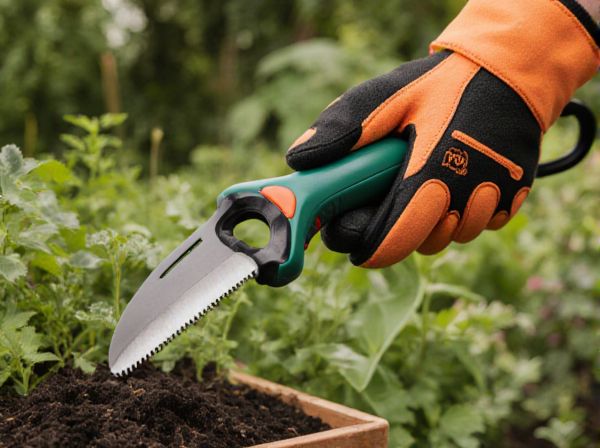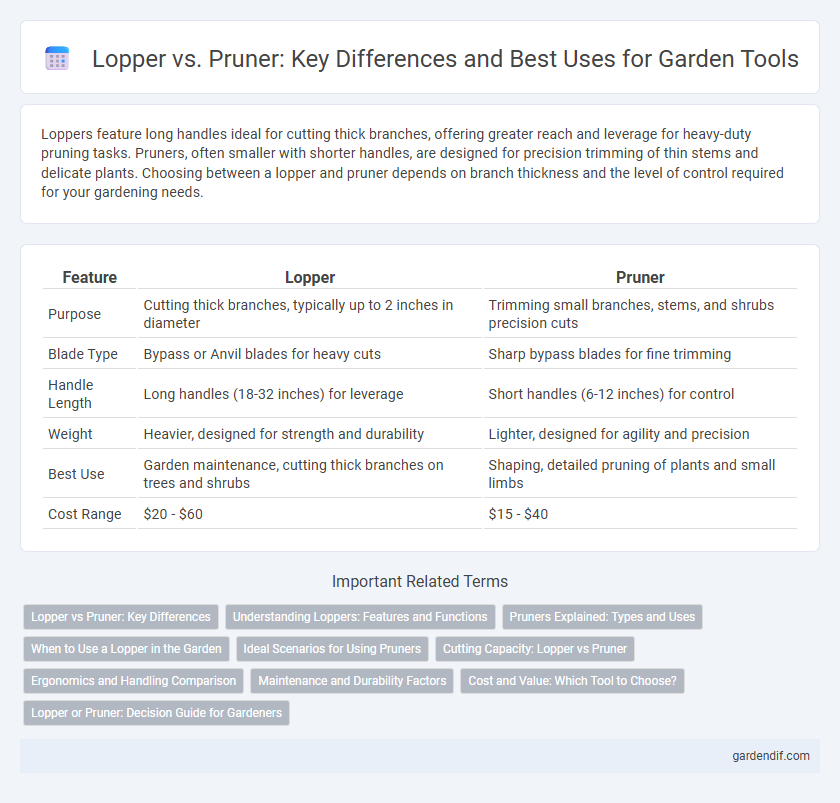
Lopper vs Pruner Illustration
Loppers feature long handles ideal for cutting thick branches, offering greater reach and leverage for heavy-duty pruning tasks. Pruners, often smaller with shorter handles, are designed for precision trimming of thin stems and delicate plants. Choosing between a lopper and pruner depends on branch thickness and the level of control required for your gardening needs.
Table of Comparison
| Feature | Lopper | Pruner |
|---|---|---|
| Purpose | Cutting thick branches, typically up to 2 inches in diameter | Trimming small branches, stems, and shrubs precision cuts |
| Blade Type | Bypass or Anvil blades for heavy cuts | Sharp bypass blades for fine trimming |
| Handle Length | Long handles (18-32 inches) for leverage | Short handles (6-12 inches) for control |
| Weight | Heavier, designed for strength and durability | Lighter, designed for agility and precision |
| Best Use | Garden maintenance, cutting thick branches on trees and shrubs | Shaping, detailed pruning of plants and small limbs |
| Cost Range | $20 - $60 | $15 - $40 |
Lopper vs Pruner: Key Differences
Loppers feature long handles designed for cutting thicker branches up to 2 inches in diameter, offering greater leverage and reach compared to pruners. Pruners, also known as hand or secateur pruners, are compact tools ideal for precision trimming of smaller stems and branches less than 3/4 inch thick. The key difference lies in their size, cutting capacity, and intended use: loppers excel at heavier pruning tasks, while pruners provide detailed, close-up cuts for gardening and shaping plants.
Understanding Loppers: Features and Functions
Loppers are garden tools designed with long handles and sharp blades to cut through thick branches up to 2 inches in diameter, providing greater leverage and precision compared to pruners. Their extendable handles and bypass or anvil blade types help reduce hand fatigue while ensuring clean cuts, which promotes healthier plant growth. Commonly used for heavier-duty pruning tasks, loppers excel in reaching higher or thicker branches that are difficult to manage with smaller pruners.
Pruners Explained: Types and Uses
Pruners, also known as hand pruners or secateurs, are essential gardening tools designed for cutting branches up to 3/4 inch thick, making them ideal for precise trimming and shaping of plants. Common types include bypass pruners, which operate with two blades passing by each other for clean cuts, and anvil pruners, which use a single blade that closes onto a flat surface for tougher branches. Their uses range from pruning shrubs and flowers to harvesting fruits, offering gardeners versatility and control in plant maintenance.
When to Use a Lopper in the Garden
A lopper is ideal for cutting thicker branches between 1 to 2 inches in diameter, making it essential for trimming hard-to-reach limbs and maintaining tree health. Unlike pruners, which are suited for smaller stems and light pruning, loppers provide the leverage and blade length needed for more substantial cuts without damaging the plant. Use loppers for shaping, thinning, and removing dead or overgrown branches to promote better air circulation and growth in your garden.
Ideal Scenarios for Using Pruners
Pruners are ideal for precision cutting of small branches and stems, typically up to 3/4 inch thick, making them perfect for detailed gardening tasks such as deadheading flowers or trimming shrubs. Their compact size and sharp blades allow for clean cuts that promote healthy plant growth without causing trauma. Pruners excel in scenarios requiring control and accuracy, especially in confined spaces where larger tools like loppers would be cumbersome.
Cutting Capacity: Lopper vs Pruner
Loppers feature longer handles and heavier blades, providing a cutting capacity of up to 2 inches in diameter, ideal for thick branches and tougher pruning tasks. Pruners, with shorter blades and handles, are designed for precision and typically handle stems and branches up to 3/4 inch thick. Selecting the appropriate tool depends on the branch thickness, with loppers suited for larger cuts and pruners for fine, detailed work.
Ergonomics and Handling Comparison
Loppers feature long handles that provide superior leverage for cutting thicker branches, resulting in less hand strain and improved ergonomics during prolonged use. Pruners, with their compact design and ergonomic grips, offer precise control and ease of handling, ideal for detailed trimming but may cause fatigue when used extensively on tougher branches. Selecting between loppers and pruners depends on balancing the need for leverage against the requirement for maneuverability and fine control.
Maintenance and Durability Factors
Loppers typically require regular sharpening and occasional oiling to maintain optimal cutting performance and prevent rust, enhancing their durability over time. Pruners, often equipped with replaceable blades and springs, demand more frequent maintenance to ensure precise cuts and long-term functionality. Both tools benefit from proper cleaning after use, but loppers generally last longer with minimal upkeep due to their robust construction and heavier materials.
Cost and Value: Which Tool to Choose?
Loppers generally offer greater leverage and cutting power for thick branches, providing better value for heavy-duty pruning tasks, while pruners excel in precision and ease of use for smaller, detailed cuts. The cost of loppers can be higher due to their robust construction, but they deliver long-term durability and efficiency, making them a worthwhile investment for extensive gardening. Pruners, often more affordable and lightweight, are ideal for budget-conscious users needing accuracy and control in frequent trimming activities.
Lopper or Pruner: Decision Guide for Gardeners
Loppers and pruners serve distinct functions in garden maintenance, with loppers designed for cutting thicker branches up to 2 inches in diameter, offering leverage and comfort for heavy-duty trimming. Pruners, or hand pruners, excel at precision cutting of smaller stems and branches under 3/4 inch, promoting plant health through clean cuts. Gardeners should select loppers for shaping trees and large shrubs while reserving pruners for delicate tasks like deadheading flowers and detailed pruning.
Lopper vs Pruner Infographic

 gardendif.com
gardendif.com